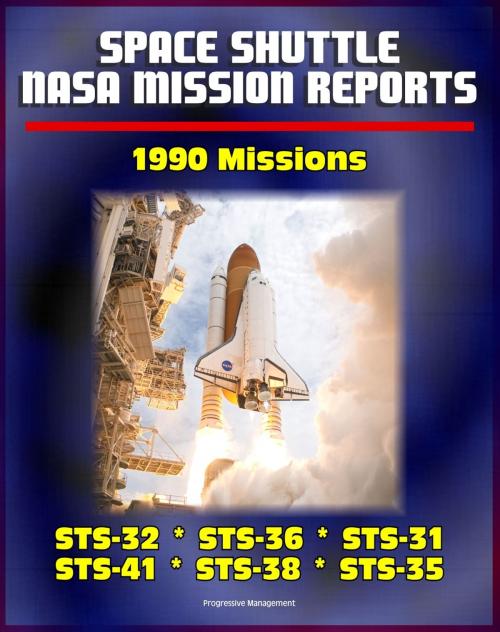Space Shuttle NASA Mission Reports: 1990 Missions, STS-32, STS-36, STS-31, STS-41, STS-38, STS-35
Nonfiction, Science & Nature, Science, Physics, Astronomy, Other Sciences, History| Author: | Progressive Management | ISBN: | 9781465902207 |
| Publisher: | Progressive Management | Publication: | January 5, 2012 |
| Imprint: | Smashwords Edition | Language: | English |
| Author: | Progressive Management |
| ISBN: | 9781465902207 |
| Publisher: | Progressive Management |
| Publication: | January 5, 2012 |
| Imprint: | Smashwords Edition |
| Language: | English |
These official final program mission reports issued by the NASA Johnson Space Center cover missions in 1990: STS-32, STS-36, STS-31, STS-41, STS-38, and STS-35. In these thorough reports, with information and specifics not available on NASA website mission descriptions, each orbiter system is reviewed in detail along with technical information on performance and anomalies.
STS-32: The primary objective of this flight was to successfully deploy the SYNCOM IV-F5 satellite and to retrieve the Long Duration Exposure Facility (LDEF) satellite, which had been placed in orbit on April 6, 1984, by the STS-41C mission. The crew for this thirty-third flight of the Space Shuttle was Daniel C. Brandenstein, Capt., USN, Commander; James D Wetherbee, Lt. Cdr., USN, Pilot; Bonnie J. Dunbar, Ph.D., Mission Specialist 1; Marsha S. Ivins, Mission Specialist 2; and G. David Low, Mission Specialist 3.
STS-36: The STS-36 mission was a classified Department of Defense mission. The crew for this thirty-fourth flight of the Space Shuttle was John O. Creighton, Capt., U.S. Navy, Commander; John H. Casper, Col. U. S. Air Force, Pilot; David C. Hilmers, Lt. Col., U. S. Marine Corps, Mission Specialist 1; Richard M. Mullane, Col., U. S. Air Force, Mission Specialist 2; and Pierre J. Thuot, Lt. Cdr., U. S. Navy, Mission Specialist 3.
STS-31: The primary objective of the mission was to place the Hubble Space Telescope (HST) into a 330 nmi. circular orbit having an inclination of 28.45 degrees. The crew for this thirty-fifth flight of the Space Shuttle was Loren J. Shriver, Commander; Charles F. Bolden, Pilot; Bruce McCandless, Mission Specialist 1; Steven A. Hawley, Mission Specialist 2; and Kathryn D. Sullivan, Mission Specialist 3.
STS-41: The primary objective of the STS-41 mission was to successfully deploy the Ulysses/inertial upper stage (IUS)/payload assist module (PAM-S) spacecraft. The crew for this thirty-sixth flight of the Space Shuttle was Richard N. Richards, Capt., USN, Commander; Robert D. Cabana, Lt. Col., USMC, Pilot; Bruce E. Melnick, Cmdr, USCG, Mission Specialist 1; William M. Shepard, Capt., USN, Mission Specialist 2; and Thomas D. Akers, Major, USAF, Mission Specialist 3.
STS-38: The STS-38 mission was a classified Department of Defense mission. The crew for this thirty-seventh flight of the Space Shuttle was Richard O. Covey, Col., USAF, Commander; Frank L. Culbertson, Capt., USN, Pilot; Charles D. Gemar, Capt., U.S. Army, Mission Specialist 1; Robert C. Springer, Col., USMC, Mission Specialist 2; and Carl J. Meade, Major, USAF, Mission Specialist 3.
STS-35: The primary objectives of this flight were to successfully perform the planned operations of the Ultraviolet Astronomy (Astro-1) payload and the Broad-Band X-Ray Telescope (BBXRT) payload in a 190-nmi. circular orbit which had an inclination of 28.45 degrees. The crew for this thirty-eighth flight of the Space Shuttle was Vance D. Brand, Commander; Guy S. Gardner, Colonel, USAF, Pilot; Jeffrey A. Hoffman, Ph.D, Mission Specialist 1; John M. Lounge, Mission Specialist 2; Robert A. Parker, Ph.D, Mission Specialist 3; and Samuel T. Durrance, Ph.D, and Ronald A. Parise, Ph.D., Payload Specialists.
These official final program mission reports issued by the NASA Johnson Space Center cover missions in 1990: STS-32, STS-36, STS-31, STS-41, STS-38, and STS-35. In these thorough reports, with information and specifics not available on NASA website mission descriptions, each orbiter system is reviewed in detail along with technical information on performance and anomalies.
STS-32: The primary objective of this flight was to successfully deploy the SYNCOM IV-F5 satellite and to retrieve the Long Duration Exposure Facility (LDEF) satellite, which had been placed in orbit on April 6, 1984, by the STS-41C mission. The crew for this thirty-third flight of the Space Shuttle was Daniel C. Brandenstein, Capt., USN, Commander; James D Wetherbee, Lt. Cdr., USN, Pilot; Bonnie J. Dunbar, Ph.D., Mission Specialist 1; Marsha S. Ivins, Mission Specialist 2; and G. David Low, Mission Specialist 3.
STS-36: The STS-36 mission was a classified Department of Defense mission. The crew for this thirty-fourth flight of the Space Shuttle was John O. Creighton, Capt., U.S. Navy, Commander; John H. Casper, Col. U. S. Air Force, Pilot; David C. Hilmers, Lt. Col., U. S. Marine Corps, Mission Specialist 1; Richard M. Mullane, Col., U. S. Air Force, Mission Specialist 2; and Pierre J. Thuot, Lt. Cdr., U. S. Navy, Mission Specialist 3.
STS-31: The primary objective of the mission was to place the Hubble Space Telescope (HST) into a 330 nmi. circular orbit having an inclination of 28.45 degrees. The crew for this thirty-fifth flight of the Space Shuttle was Loren J. Shriver, Commander; Charles F. Bolden, Pilot; Bruce McCandless, Mission Specialist 1; Steven A. Hawley, Mission Specialist 2; and Kathryn D. Sullivan, Mission Specialist 3.
STS-41: The primary objective of the STS-41 mission was to successfully deploy the Ulysses/inertial upper stage (IUS)/payload assist module (PAM-S) spacecraft. The crew for this thirty-sixth flight of the Space Shuttle was Richard N. Richards, Capt., USN, Commander; Robert D. Cabana, Lt. Col., USMC, Pilot; Bruce E. Melnick, Cmdr, USCG, Mission Specialist 1; William M. Shepard, Capt., USN, Mission Specialist 2; and Thomas D. Akers, Major, USAF, Mission Specialist 3.
STS-38: The STS-38 mission was a classified Department of Defense mission. The crew for this thirty-seventh flight of the Space Shuttle was Richard O. Covey, Col., USAF, Commander; Frank L. Culbertson, Capt., USN, Pilot; Charles D. Gemar, Capt., U.S. Army, Mission Specialist 1; Robert C. Springer, Col., USMC, Mission Specialist 2; and Carl J. Meade, Major, USAF, Mission Specialist 3.
STS-35: The primary objectives of this flight were to successfully perform the planned operations of the Ultraviolet Astronomy (Astro-1) payload and the Broad-Band X-Ray Telescope (BBXRT) payload in a 190-nmi. circular orbit which had an inclination of 28.45 degrees. The crew for this thirty-eighth flight of the Space Shuttle was Vance D. Brand, Commander; Guy S. Gardner, Colonel, USAF, Pilot; Jeffrey A. Hoffman, Ph.D, Mission Specialist 1; John M. Lounge, Mission Specialist 2; Robert A. Parker, Ph.D, Mission Specialist 3; and Samuel T. Durrance, Ph.D, and Ronald A. Parise, Ph.D., Payload Specialists.















